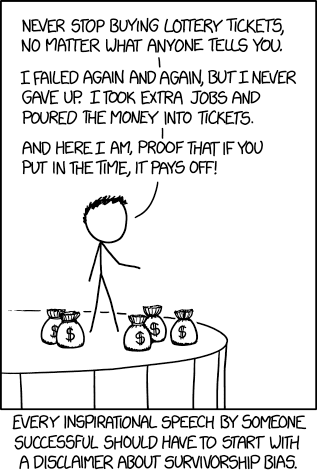In last week’s edition, we looked at how two farmers, Bill and Ann, can cooperate to improve the overall productivity of their farms. This lesson is generalizable well beyond farming – cooperation, be it between investment strategies or basketball teammates, can produce a “whole is greater than the sum of its parts” effect.
Some interesting research is being done on this topic by Ole Peters and the London Mathematical Laboratory that culminated in a paper in the Journal Nature last year called The Ergodicity Problem in Economics.
At the risk of being hyperbolic, I think it is one of the most important papers I’ve ever read and I have sent it to roughly a gazillion people so, in the interest of disseminating some of the ideas, I wanted to write a non-technical summary here.
I’ve written previously about ergodicity and why its such an important concept for investors and entrepreneurs. But, for the purposes of this paper, we only need to understand that ergodicity means that the time average of a system equals its expectation value or ensemble average.
Said another way, a pretty simple way to identify an ergodic situation is to ask do I get the same result if I:
- Look at one individual’s trajectory across time.
- Look at a bunch of individual’s trajectories at a single point in time.
If yes: ergodic
If not: non-ergodic
Six people playing Russian Roulette once get a different outcome (5 win, 1 lose) than one person playing Russian Roulette six times (you are guaranteed to lose). That makes it non-ergodic, one individual over time gets a different outcome than six individuals.
For example, If you survey six people who played Russian Roulette for a $1 million dollar prize, on average, five of them will be very happy because they won a million bucks. One will not respond.

Using an ensemble average of the six people suggests that Russian Roulette is a very nice game where you win lots of money and so it would be wise to play.
Common sense suggests otherwise. If you, as a single individual, were to play Russian Roulette over and over, you would not be very happy with the long term outcome.
In practice, pretty much all economic decisions are non-ergodic. You only have one career and one investment path, but we often don’t think about this way.
A lot of economic and investment theory is predicated on a major error: it assumes most economic games are ergodic, but they aren’t.
When an investment prospectus says that their strategy makes 25% returns on average, that sounds pretty great, but there’s nothing to say that it isn’t the same as playing a Russian Roulette. In our $1 million Russian Roulette game, the “average” outcome was winning $833,000.
To make an economic or investment decision, I want to know how my personal fortune grows or shrinks under different scenarios, not how the average person’s fortune grows or shrinks.
I don’t care that the average person “wins” at Russian Roulette, I care about what happens to me, if I keep playing over time. If I make an investment and it earns 25% per year for 10 years then loses 99% in one year, it’s a bad investment, even though an average year was very good.
The observed behavior of people making economic decisions often deviates from what traditional economic theory would predict as optimal.
This has led to the belief in “irrationality” and “biases” as a way to explain human behavior deviating from what economic models predict.
However, many “biases” disappear when you realize that people intuitively understand ergodicity. An economist or investment advisor can lecture you all day about how Russian Roulette is a “positive expected value” game, basic reasoning makes it very clear that this is a bad idea.
You don’t need an economics degree to understand that Russian Roulette six times in a row means you’re gonna have a bad time.

The way traditional economics deals with this paradox is by ascribing this human behavior to “irrational biases” and expected utility theory.
Expected utility theory says that some people don’t participate in a positive expectation, but non-ergodic game is because they are “conservative” or “scared” as opposed to “aggressive” or “brave.”
According to this thinking, an “aggressive” or “brave” investor would be willing to participate in Russian Roulette, whereas a “conservative” or “scared” investor would not.
Ergodicity economics starts from a different premise: individuals should optimize for growth rate over time, not across many people.
We care about our personal ROI when we take a new job or make an investment, not how the average person does.
In maximizing the expectation value, expected utility theory assumes that individuals can interact with copies of themselves in parallel universes.
Consider a slightly different version of the Russian Roulette game. You can play Russian Roulette as many times as you would like and each time you “win,” your net worth doubles. You start with a million bucks and if you win the first round, it doubles 2 million, then 4 million, and so on.
If you could make a million copies of yourself and each copy got to play the game in a parallel universe, that would be pretty sweet. One version of yourself would get lucky and turn into an intergalactic gazillionaire.
“On average” you would be extremely rich, but reality doesn’t work that way. We do not live spread out across a multiverse. We live one life, through time. We care about what happens to us, not an ensemble of other people living other lives.

Ergodicity economics suggests that it is not so much that some people are more aggressive or conservative, it’s that people behave differently depending on the game they are playing.
This is supported by an experiment in which a group of neuroscientists from Copenhagen split participants into two groups.
On Day 1, the participants played a multiplicative game (less ergodic).
On Day 2, the exact same participants played an additive game (more ergodic).
The returns to a multiplicative game look more like an exponential curve – you can get rich really fast, but you can also go broke really fast. The Russian Roulette example where you start with a million dollars and it double every time you “win” is a multiplicative game. You are either going to end up as an intergalactic gazillionaire or nothing.
Expected Utility Theory would say that it doesn’t matter which game they are playing since the expectation values are the same on both days. It only matters whether certain people are aggressive or conservative.
Aggressive players would play aggressively on both days and conservative players would play conservatively on both days.
Ergodicity economics predicts something different: players playing the multiplicative game would play it more conservatively because the game is less ergodic. If you are playing a multiplicative game that is less ergodic then you really want to minimize your losses as things can get ugly quick, so your decisions will tend to look conservative.
On the other side, participants playing the additive game would be more “aggressive” because that is the long term wealth maximizing approach.
Approaching the additive game “aggressively” and the multiplicative game “conservatively” both have one thing in common: Participants would be maximizing the growth rate of their individual wealth over time NOT the wealth of a million copies of themselves spread out across the multiverse.
Playing conservatively in the multiplicative game would maximize wealth in that game.
Playing more aggressively in the additive game would maximize wealth there.
And, indeed, this is how participants behaved.
In practice, most of the economic games we play from career choices to investment choices are multiplicative and so it is not that many people are too “risk-averse” or “conservative” because of some psychological bias, it is that when you are maximizing your own long term wealth, you should be just as worried about the downside as the upside.
Though this line of thinking has been largely ignored by traditional economists, it has been widely appreciated by actual practitioners, most famously in the Kelly Criterion which acknowledges ergodicity economics.
Ergodicity economics shows people (rationally) maximize the long-term growth of their wealth and that much of what we call “risk aversion” is rational avoidance of non-ergodic games like Russian Roulette.
Last Updated on June 6, 2025 by Taylor Pearson

